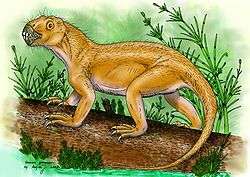Suminia
| Suminia | |
|---|---|
 | |
| Suminia getmanovi | |
| Scientific classification | |
| Kingdom: | Animalia |
| Phylum: | Chordata |
| Order: | Therapsida |
| Family: | †Otsheridae |
| Genus: | †Suminia Ivachnenko, 1994 |
| Species: | †S. getmanovi |
| Binomial name | |
| Suminia getmanovi Ivachnenko, 1994 | |
Suminia getmanovi is an extinct species of anomodont, that lived 260 million years ago in the late Permian ("zone II"). This anomodont was discovered in Kotelnich on the Vyatka River Russia. It was found in sandstone sediment, so it most likely was a delta-dwelling species, but this is not conclusive, as the specimen may have been washed downriver, away from its habitat. S. getmanovi has teeth that are heavily abraded, suggesting a diet consisting of plant material with a high silica content. More recently found fossils indicate that it led an arboreal lifestyle.
Features
The teeth were quite large for its size containing a single cusp per tooth with many serrations as in a serrated knife. These teeth were replaced throughout its life cycle. The eye socket was fairly large and placed near the temporal opening, separated by a thin postorbital bar. Suminia had grasping hands, which has led researchers to conclude that it was a tree-climbing animal, the earliest known such vertebrate species found thus far.[1]
See also
External links
References
- Patricia Vickers-Rich and Thomas H. Rich, The Great Russian Dinosaurs, Gunter Graphics, 1993, Pg 37.
- Rybczynski, N. (2000), Cranial anatomy and phylogenetic position of Suminia getmanovi, a basal anomodont (Amniota: Therapsida) from the Late Permian of Eastern Europe", Zoological Journal of the Linnean Society 130:329-373
- Jörg Fröbisch and Robert R. Reisz (2009). The Late Permian herbivore Suminia and the early evolution of arboreality in terrestrial vertebrate ecosystems. Proceedings of the Royal Society B, Online First doi:10.1098/rspb.2009.0911